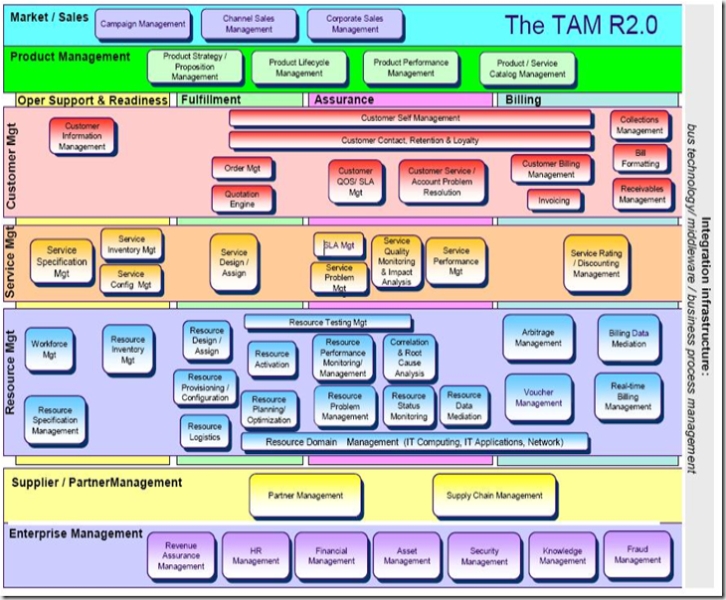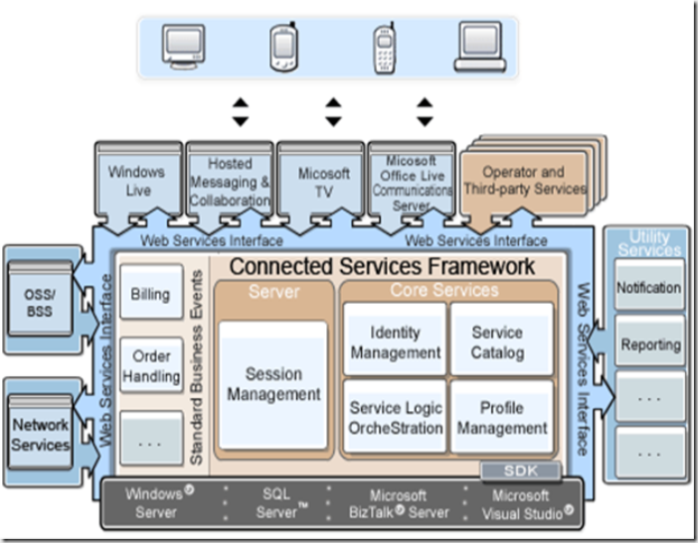Service Delivery Platform (SDP) for the Enterprise
I'm noticing a lot of great improvements in Enterprise Architecture Frameworks, namely FEAF, TOGAF, Gartner EAF and ITIL (Yes, I see ITIL as an EAF now). They are embracing similar improvement themes like Business Strategy linkage, enabling agile business via Service-Oriented Architecture approaches, iterative delivery processes, federated team models, and process, information and system complexity reduction.
The good news is that they are learning. And the bad news, unfortunately, is that they are learning and each new concept they gradually expand and adopt takes a bit of catch-up with what industry thought-leaders already know and it takes time to get new ideas incorporated into EAF documention.
For those of us who have to sign-up and deliver to our CxO executives useful architectures usually anchor, somewhat loosely, to one of the popular EAFs out there and then liberally pull from the best practices that we discover. I'd like to highlight a best practice from a somewhat lesser known EAF called New Generation Operations Support Services (NGOSS) that may radically impact the way your EAF implementation looks today. The best practice is the notion of a Service Delivery Platform (SDP) from the telecommunications industry.
We all know that SOA is a powerful tool to enable an agile business but we don't know what the nuts and bolts, bits and bobs of the resulting well-formed business process, information and system architectures are if we use your typical SOA approach. Well, it turns out that the telecom industry has largely solved this and are working on the challenges of what comes next.
Huh? Am I saying that there's more work to improve our architecture after we get a first serious rev of architecture based on SOA? Yes, there is! Through continuous improvement and change in the business, we will continually modify our architecture to advance our business and be more competitive.
For example, based on the needs of faster delivery of services, there are higher levels of sophistication in how to do Service Management with features like Service Naming, Registry and Location Services, Service Policy Management, Service Quality Management, Service Configuration Management, and Service Rating and Discounting Management.
Another example, is the sophistications in how an enterprise will handle supporting shared services. Enterprise Architectures will need to support shared services and will require sophistications in Dev and Test environments, Governance process and team models, SDLC modifications, Customer Support and Service Consultation/On-boarding.
And finally, there are levels of sophistication how the enterprise architecture will look in S+S scenarios such as process, information and system integration with cloud services. Or, resolve how the architecture will handle partner collaboration and customer-centric challenges the business strive for.
Some may argue that these are already included in a SOA approach - these people are thought leaders and are very rare. For the rest, these bits of sophistication aren't even on the radar yet.
The point is that they definitely are involved and most mainstream SOA approaches out there today don't know this yet. The NGOSS framework is focused on these aspects and through the competitive, free market forces in the telecom industry, they are improving on their framework relatively rapidly. In fact, I predict that enterprises will begin to adopt them and we will see more and more of the SDP concepts built into enterprise products moving forward.
I suggest you take a look at the NGOSS and eTOM documents produced by the TeleManagement organization. Here's their website. Register for free and then start looking at the free material. Pay particular attention to the Enhanced Telecom Operations Map (eTOM), Technology Application Map (see image below), Technology-Neutral Architecture models and Shared Information Data (SID) model that make up the NGOSS EAF.
Of course, NGOSS is more geared to delivery of monetized services than support of an enterprise shared services. But the capabilities they have created to solve for service delivery in a Service Delivery Platform are relevant for the enterprise.
That's my main point of this blog post. I see value in NGOSS/eTOM as a catalyst for improvement in an Enterprise Architecture via, at the very least, a mature Service Delivery Platform to realize SOA. Hence, SDP for the Enterprise.
As it turns out, Microsoft has a strong competency in the SDP space and have a product named Connected Systems Framework (CSF) which is born from the telco industry but generic enough to support an enterprise. Here's more info on CSF: https://msdn2.Microsoft.com/en-us/library/aa445859.
Here's a rough CSF technical architecture diagram to help convey some of the components included in the CSF solution.
Also, have a look at the article "Efficient Software Delivery Through Service-Delivery Platforms" by Gianpaolo Carraro, Fred Chong, and Eugenio Pace found here: https://msdn2.microsoft.com/en-us/architecture/bb735303.aspx
Now, for enterprises seeking to offer Services in a S+S business model, there is much more here to leverage. More on this later.

